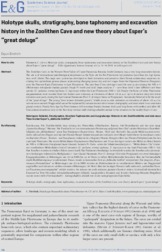Holotype skulls, stratigraphy, bone taphonomy and excavation history in the Zoolithen Cave and new theory about Esper’s “great deluge”
Diedrich, Cajus
Diedrich, Cajus, 2014: Holotype skulls, stratigraphy, bone taphonomy and excavation history in the Zoolithen Cave and new theory about Esper’s “great deluge”. In: E&G – Quaternary Science Journal; Vol.63, No.1, p.78-98, DOI: 10.3285/eg.63.1.05.
 |
Dokument öffnen: |
The Zoolithen Cave, in the Wiesent River Valley of Upper Franconia, Bavaria, South Germany, has a very long excavation history. The site is of international paleobiological importance as the Type site for five Pleistocene top predators (cave bear, Ice Age hyena, lion, wolf, dhole). This large cave system has developed in three elevations and preserves three fluvial sedimentary sequences including two speleothem genesis phases representing changing ponor, dry and wet stages from the Oligocene/Miocene (Neogene), over the Pliocene/Early Pleistocene to Late Pleistocene. The cave bear Ursus deningeri used the cave as den during the MIS 6–9 (Holsteinian interglacial-Saalian glacial). Single P4 tooth and skull shape analyses (“= cave bear clock”) date different cave bear species (U. spelaeus eremus/spelaeus, U. ingressus) within the Late Pleistocene (MIS 3–5d). Finally the bones of other Pleistocene megamammals were washed from two former cave entrances at elevations of about 455 m a.s.l. up to 30 meters deep into lower elevation cave parts, during the Last Glacial Maximum (Post-U. deningeri times or Postglacial), -historically believed to be the result of the “great deluge”. The young “river terrace dolomite gravels” which occur as relic sediments at elevations of about 455 a.s.l in several caves around Muggendorf cannot be explained by natural erosion/river terrace stratigraphy, and must relate to an uncertain glacial context. Finally Iron Age (La Tène) humans left secondary burials (human skulls and long bones with pottery and after-life food animal donations) only in the first deep vertical shaft (Aufzugsschacht) similar to the situation in the nearby Esper’s Cave.

